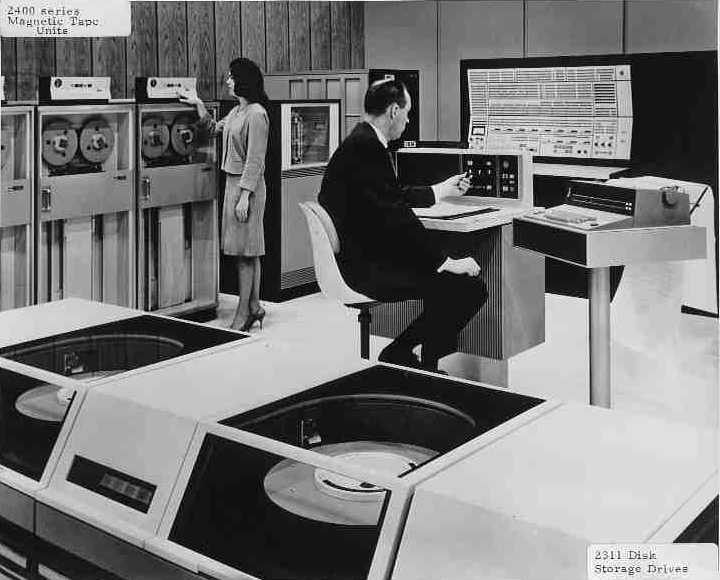The IBM 2311 Disk Drive and 2400 Tape Drive

Early-to-mid 1960s. Foreground: IBM 2311 Disk Storage Drives, providing random direct access to 7.25 million 8-bit bytes per removeable disk pack. In Packed Decimal Mode the capacity is 14.5 numeric characters. Eight drives can be attached to a single control unit for a total of 58MB or 116 million digits.
Transfer rate: 156,000 bytes/sec Average seek time: 85 milliseconds Track-to-track access time: 30 milliseconds Recording tracks: 2000 Cylinders: 200
Not shown is the IBM 2314 Direct Access Storage Facility, a newer model disk drive with a capacity of 25.87MB, nearly four times the 2311, and double the transfer rate (312,000 bytes/sec).
Background: IBM 2400 9-track 800bpi tape drives. This was IBM's first 9-track model, and therefore the first model capable of recording EBCDIC (8-bit) or ASCII (7-bit) information; earlier drives were 7-track and could record only BCD (a 6-bit character set composed of digits, uppercase Roman letters, and a handful of symbols). And between the two figures, an IBM 2301 Drum Storage Unit (thanks to Ralph Brandt for noticing it). On the right, an IBM 360 Model 75 control panel (like the one in our own machine room).
Center: Operator devices including an IBM 1052 Console Typewriter.
Photo: IBM [32].
FROM: Bob Comer, Forensic & Electronic Research, Inc. Magnolia, Ohio, August 2010.I was a computer operator / computer room supervisor / tech. support person for 31 years. I operated my first mainframe computer system in 1972, an IBM System 360, model 30. It had four 2311 disk drives. The system also had tape drives similar to the ones in this picture. Those tape drives had vertical vacuum columns, as can be seen below the tapes. That allowed the tape to be stretched out and move at high speed.
I'd like to point out that this picture shows the head assembly in each 2311 drive. It retracted into a hole to allow the disk pack to be removed / inserted. Due to the glass cover, you could watch the head assembly move in and out of the moving disk pack. The number of disks in the disk pack can't be seen in this picture as it is dark below the top disk surface. A plastic device that looked like a cake cover was used to move a disk pack. This device is not shown in this picture. It had a handle on the top that was used to lock or unlock the disk pack on the spindle. The handle also made it easy to move the disk pack around without damage.